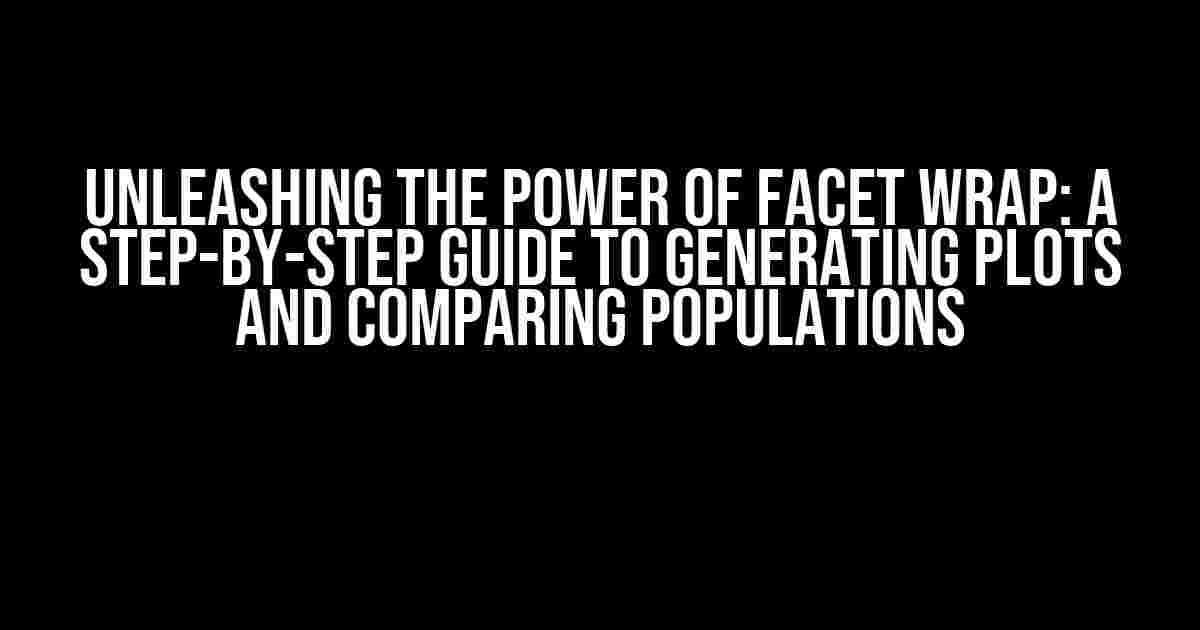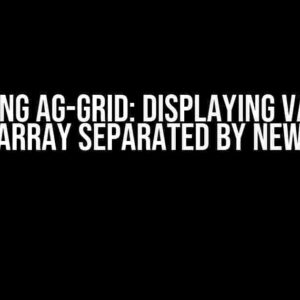If you’re a data analyst or scientist looking to level up your visualization game, you’re in the right place! In this article, we’ll dive into the world of facet wrapping and explore how to generate stunning plots that reveal the secrets of your data. Specifically, we’ll focus on using facet wrap to compare populations and uncover hidden patterns.
What is Facet Wrap?
Facet wrap is a visualization technique that allows you to split your data into subsets, or “facets,” and display them in agrid-like arrangement. This approach is particularly useful when working with large datasets or when you need to compare multiple groups within a single plot. By wrapping facets, you can create a concise and informative visualization that tells a story about your data.
Why Use Facet Wrap for Comparing Populations?
When comparing populations, you often need to consider multiple variables and how they interact with each other. Facet wrap provides an elegant solution to this problem by allowing you to:
- Visualize multiple variables within a single plot
- Compare different populations side-by-side
- Identify patterns and relationships that might be hidden in individual plots
By using facet wrap, you can gain a deeper understanding of how different populations respond to various factors, making it an ideal technique for researchers, analysts, and scientists.
Step-by-Step Guide to Generating Plots with Facet Wrap
Now that we’ve covered the basics, let’s dive into the practical implementation of facet wrap using R and the ggplot2 package. We’ll use the built-in mtcars dataset to illustrate the process.
library(ggplot2)
library(dplyr)
# Load the mtcars dataset
data(mtcars)
# Create a new column for the population (e.g., European, American, or Japanese cars)
mtcars$population <- ifelse(mtcars$cyl == 4, "European",
ifelse(mtcars$cyl == 6, "American", "Japanese"))
We'll create a simple scatter plot to compare the relationship between mpg (miles per gallon) and wt (weight) for each population.
ggplot(mtcars, aes(x = wt, y = mpg)) +
geom_point() +
facet_wrap(~ population, ncol = 3) +
labs(title = "Comparison of MPG vs. Weight by Population",
subtitle = "Facet Wrap Example") +
theme_classic()
This code generates the following plot:
|
|
In this plot, we've used facet_wrap to create three facets, one for each population (European, American, and Japanese). The ~ population syntax specifies the column to use for faceting, and the ncol = 3 argument sets the number of columns in the facet grid.
Customizing Your Facet Wrap
To take your facet wrap to the next level, you can customize various aspects of the visualization:
-
facet_wraparguments:scales: control the scale of each facet (e.g., free, fixed, or a custom function)space: adjust the spacing between facets (e.g., fixed, free, or a custom value)
-
Geom layers:
geom_point: change the point shape, color, or sizegeom_line: add a regression line or a smoothing curve
-
Theme elements:
theme_classic(): use a built-in theme or create a custom themelabs(): add titles, subtitles, and axis labels
Here's an updated example that incorporates some of these customizations:
ggplot(mtcars, aes(x = wt, y = mpg)) +
geom_point(size = 3, color = "blue") +
geom_smooth(method = "lm", se = FALSE) +
facet_wrap(~ population, ncol = 3, scales = "free") +
labs(title = "Comparison of MPG vs. Weight by Population",
subtitle = "Customized Facet Wrap Example") +
theme_classic() +
theme(panel.grid = element_blank(),
axis.text = element_text(size = 12),
axis.title = element_text(size = 14, face = "bold"))
This customized plot includes:
- Larger blue points
- A linear regression line for each facet
- Free scales for each facet (i.e., each facet has its own y-axis scale)
- A custom theme with bold axis titles and larger axis text
Comparing Populations: A Practical Example
Now that we've covered the basics of facet wrap, let's apply this technique to a real-world example. We'll use the gapminder dataset to compare the relationship between gdpPercap (GDP per capita) and life Expectancy across different continents.
library(gapminder)
gapminder$continent <- factor(gapminder$continent,
levels = c("Africa", "Americas", "Asia", "Europe", "Oceania"))
ggplot(gapminder, aes(x = gdpPercap, y = lifeExp)) +
geom_point() +
facet_wrap(~ continent, ncol = 2) +
labs(title = "Comparison of GDP per Capita vs. Life Expectancy by Continent",
subtitle = "Facet Wrap Example") +
theme_classic()
This code generates the following plot:
|
|
In this plot, we've faceted the data by continent, allowing us to visualize the relationship between gdpPercap and lifeExp for each region. This comparison reveals interesting patterns, such as:
- Africa has a strong positive relationship between GDP per capita and life expectancy
- The Americas and Europe have a weaker positive relationship
- Asia and Oceania exhibit a more scattered relationship
By using facet wrap, we've uncovered these insights and gained a deeper understanding of the complex relationships between these variables across different populations.
Conclusion
In this article, we've explored the power of facet wrap for generating plots and comparing populations. By following the step-by-step guide and customizing your facet wrap, you can create informative and visually appealing visualizations that reveal hidden patterns and relationships in your data.
Remember, facet wrap is a versatile technique that can be applied to various data types and scenarios. Experiment with different datasets, variables, and customizations to unlock new insights and take your data visualization to the next level!
Frequently Asked Question
Get the lowdown on generating plots with facet wrap and comparing populations. We've got the scoop on the top questions and answers!
How do I generate a plot with facet wrap in ggplot2?
To generate a plot with facet wrap in ggplot2, you can use the facet_wrap() function. This function allows you to create small, multiple plots that are organized in a grid-like structure. You can specify the variables to facet by using the ~ symbol. For example: ggplot(data, aes(x = x, y = y)) + geom_point() + facet_wrap(~ variable). This will create a separate plot for each level of the variable.
What types of plots can I create with facet wrap?
The possibilities are endless! With facet wrap, you can create a variety of plots, including scatter plots, line plots, bar plots, histograms, and more. You can also customize the appearance of your plots by adding themes, changing colors, and adding annotations.
How do I compare populations using facet wrap?
Comparing populations with facet wrap is a breeze! Simply facet your data by the population variable, and ggplot2 will create separate plots for each population. You can then easily compare the distributions, means, or other characteristics of the populations.
Can I customize the appearance of my facet wrap plots?
Absolutely! You can customize the appearance of your facet wrap plots by adding themes, changing colors, adding annotations, and more. You can also use the scales and labels arguments to customize the axis labels and scales.
What are some common use cases for generating plots with facet wrap?
Facet wrap is perfect for exploring and comparing data across different groups or populations. Some common use cases include comparing sales data by region, analyzing website traffic by device type, or visualizing customer demographics by age group.



